The Captain’s crew is in Garibaldi, Oregon, on the US Pacific Northwest coast — on a trio of Stabicrafts. Huge mountain ranges covered in tall timber peer over the rugged coastline. Icy rivers meander out to bays where creaking timber trawlers and newer steel ones are docked side-by-side like old draught horses, taking respite before their next offshore stint hauling tuna and crab from the Pacific.
The two major industries are timber milling and fishing, but tourists also come to Garibaldi in search of the legendary Big Foot, rumoured to live deep in the lush fir forests.
However, it’s the fishing we’ve come to investigate. The salmon run is on and recreational fishermen are milling about the bay in open tinnies, many of them tiller-steer. They’re also pulling crab pots and nuzzling into the shores to collect clams. We reckon it’s the perfect habitat for wheelhouse game boats, suitable for bay fishing, but with the capability of mingling with the commercial fishing fleet hunting tuna and albacore. Kiwi boat builder Stabicraft thinks so, too. They’ve been making a huge dent in the Pacific Northwest boat market since launching here more than 20 years ago.
We’d called our man at Stabicraft to see if he could organise us a local ride. He’d given us the numbers of three Stabicraft owners — John Files, Scott Sayer and David Larson. All we had to do was convince these guys it was a good idea to let some Australian blokes they’d never met jump aboard their boats and catch their fish. Oh, and we’d need some comfortable beds.
It went a bit like this: “Er, g’day mate, this is The Captain from Australia. Can you take us fishing?” we mumble down the phone. “Hello? No, I’m sorry, we’re not looking to change internet providers at the moment. Thanks for your call,” comes the response. Several confused phone calls and emails later, we finally persuade the three Americans to show us a slice of Oregon — and give us a ride aboard their Stabicrafts.
GOOD OL’ AMERICAN HOSPITALITY
It’s a long and sweaty slog across the Pacific before we touch down at Portland International at 10pm. The plan is to meet John Files’ wife, Julie, at a little farm they own near the airport. By the time we arrive, it’s well past midnight, but Julie opens the door with a welcoming smile. After making us tea, she ushers us to our rooms, saying, “You boys need anything, y’all don’t hesitate to ask, OK?”
Now, we’ve stayed in some interesting places during our travels, but the jet lag mixed with shag pile carpet, embroidered pillows and crocheted doonas makes us wonder if we’ve travelled back in time. It doesn’t matter — we’re snoring in less than a minute. We’d planned a lay day to recover from the flight and check out some of the cool cafe culture Portland is famous for. The region is one of the most progressive in the US, with legalised same-sex marriage and pot smoking par for the course. But Julie isn’t having a bar of it. At 8am, she charges in to our room, “Wakey, wakey boys! Time to get moving.”
Before we can prise the sleep from our eyes, she’s made breakfast and handed us printed instructions on how to get to the fishing shack. “Let’s get moving, got to beat the traffic!” The Captain’s breakfast reefer will have to wait.
THE FISHING SHACK
The fishing shack is a few hours from Portland in the coastal town of Rockaway Beach. It’s a hot spot for salmon and tuna, and John and Julie keep a Stabicraft 2750 Centrecab berthed at Garibaldi Marina. Julie proudly parades her adopted Aussies around the dock like a couple of celebrities. By the time we reach the shack, we’ve met the entire town — and are ready for another siesta. Just as we lie down on the quilt-covered beds, Julie hollers, “You boys can’t go to sleep, it’s happy hour and friends are coming over.”
In the living room, we’re amazed to see more than a dozen faces glued to a TV screen watching The Captain videos. “Well, this is embarrassing,” we splutter. “The Aussies are awake everyone, come say hi!” Julie announces. The last reliable memory we have is of a guy called Danny, with a Glock pistol on his belt and a half-gallon bottle of rum in his hand, saying, “They say if I feed you guys Captain Morgan we’re going to have a mighty good time!”
DINNER SORTED
“Wakey, wakey boys!” It’s still dark outside and we’re not sure if it’s all been a dream. The seedy feeling in our stomachs and pounding headaches confirms it’s not. We’re hung-over and jet-lagged, but after a big pot of black coffee we level out and prepare for the day’s fishing. We’ll be chasing Pacific salmon — chinooks and cohos specifically. They’re a highly prized sport fish on every dietician’s wish list thanks to their high nutritional content. When it comes to salmon, the only way The Captain knows how to catch them is at his local cafe, served with avocado, a poached egg and hollandaise sauce.
We’ll be chasing Pacific salmon — chinooks and cohos specifically. They’re a highly prized sport fish on every dietician’s wish list thanks to their high nutritional content. When it comes to salmon, the only way The Captain knows how to catch them is at his local cafe, served with avocado, a poached egg and hollandaise sauce.
John and Julie look to have the fishing caper sorted, muttering in some strange language about flashers, hoochies, spinners and cut plug herring. It doesn’t matter, because after a few hours on the water, we’ve hooked a beautiful silver-flanked coho salmon, destined for the smoker.
Crabbing is a big part of Garibaldi life. It involves dropping a cage with fish bait, tied to a float, then picking it up hours or days later. Fortunately, John deployed some crab traps the previous day. He hauls up the pots and suddenly massive Dungeness crabs are crawling all over the Stabi cockpit.
Skipper John might look like a mild-mannered accountant, but his Centrecab (appropriately named Happy-Ours) is set up for serious fish slaying. It’s fitted with 420HP of triple Yamaha power out back (OK, one is a trolling motor), a 500L fuel tank, downriggers, customised rod holders and a custom crab pot hauler with a winch. John says it was Julie who decided to buy the boat, “As soon as she heard about the positive buoyancy and the fact they’re virtually unsinkable, she was sold.”
John is a bit of a tech geek, even selling his GPS dog collar patent to Garmin. He’s fitted out the boat with Simrad, running a bangin’ NSS12 Evo2 display with a 4G radar upstairs. Who thought you’d need so much tech to catch salmon? When we think about salmon fishing in the Northwest, we picture Brad Pitt in A River Runs Through It — quietly wading down a gentle stream, fly rod in hand. But John is far better looking than Brad Pitt.
JOHN’S SALMON TIPS
John has a few pointers to get you started on salmon fishing. Techniques vary depending on species, location and conditions.
OCEAN COHO SALMON
Early in the morning is the time to chase ocean coho. Delta divers work well fishing under the surface, travelling at two to three miles per hour. When the fish hits, simply stop and fight it. Downriggers are also employed. Coho like bling, so 360 flashers with hoochies and/or spinners will work (bright colours on sunny days, dark colours on cloudy ones). Cut plug herring or whole anchovies bent to spin tightly work well, too. As the day progresses, the fish usually move from on top (6–15ft) to deeper (25ft). We run several depths and adjust the other rods when we find the best depth.
OCEAN CHINOOK SALMON
Chinooks can be caught with the coho techniques above, but you’ll usually find them in deeper water (towards the bottom). A sliding drop line about an arms length with a 16oz (0.5kg) weight allows you to drop down and present a spinning cut plug herring on a 6ft leader just off the bottom, trolled at a speed of about one mile per hour.
As the salmon enter the bay and rivers, the bite becomes more tidal with the best times an hour before to an hour after tide change. I like the high tide change better than low tide, but both are good. I’ll put a six-bead chain swivel halfway down the 6ft leader so it won’t twist up if weeds get on it with the rotating herring. As you move up the bay, water temperatures rise and spinners seem to get the bite.
BLOOD BATH
The fishing is hot in the bay — and apparently even hotter out wide — so we get on the blower to beef farmer Scott Sayer, owner of a Stabicraft 2500 Ultracab XL. He doesn’t take much convincing and a few hours later, rolls down the ramp at Garibaldi Marina.
“G’day mates!” Scott says in his best Aussie accent, shaking our hands. We’d expected a cap-wearing farmer in denim and cowboy boots, but Scott struts down the dock with a miniature poodle wedged under his arm wearing a pink sweater (the poodle, that is), its tongue hanging out like it had been on a 48-hour bender. Was this the Garibaldi way? Perhaps the pooch is bait, we muse, smiling and avoiding eye contact — with the poodle and Scott.
Like his poodle, Scott’s Stabi is a one of a kind. He’s peeled the decals from the boat and engine cowlings so it doesn’t look like anyone else’s. “People ask if it’s a military prototype,” he says proudly. Today we’re heading 60 nautical miles offshore, in convoy with John Files’ Centrecab. We’ve packed 200kg of ice on board each boat, hoping for a large ice bath of tuna. The bag limit is 25 fish per person and we get the impression we’re not going home until the boat is “plugged” — it physically can’t hold any more fish.
Nearing the GPS mark that signifies the hot bite, the crew deploys the lures. It’s a glass-off and Scott runs a combination of two rods and two handlines. His favourite lure comes out — the cedar plug, which is basically a piece of untreated wood with a hook jammed up its butt. We pretend to be impressed, asking where the JB Lures are stashed, but Scott just gives us a quizzical stare. The twin Yamaha F150s are spooled up to seven knots and the trap is set.
By 1pm that afternoon, our opinion of the cedar plug has changed. The kill tank and three additional coolers are packed to the brim with albacore tuna. “Hey Scott, where can we get one of those cedar plugs?” we ask casually. But he’s too busy bleeding and packing albacore on ice to hear us.
ULTRA AWESOME
Boat plugged, we head back to Garibaldi Marina to get some much-needed shut-eye. Scott has set up his 2500 Ultracab XL for overnighters. It’s got a full kitchen with a sink and cooktop, as well as a huge double berth in the bow. The handy dropdown dinette table can be folded away against the wall to create a second sleeping nook.
Speaking of sleepovers, Scott has also equipped his 2500 with serious spotlight action: front and flank light bars. In the sounder department, a Simrad NSS12 Evo3 sits neatly in the dash while the 4G radar on the hardtop scouts for birds lurking above unsuspecting tuna schools. Get those cedar plugs ready.
HIGHWAY 101
We give Julie a big bear hug and say our goodbyes to the cedar crew and Rockaway Beach. Next stop is Charleston, the biggest commercial fishing port in Oregon, four hours south on Highway 101. This famous stretch of road wraps itself along the west coast of the US, starting in Los Angeles, California and running all the way up to Seattle, Washington.
In Charleston, we meet up with retiree David Larson. He describes the area as “a mini Alaska”. His ride is a brand-spanking new Stabicraft 2750 Ultra Centrecab XL, towed by a black Caterpillar-powered GMC, which makes a Dodge Ram look like a Suzuki Jimny.
Prior to retiring, Dave ran Larson Industrial, which specialised in welding and machining — so he knows a thing or two about quality fabrication. The Ultra Centrecab XL features a big cabin with the pilot house-style windscreen, walk-around configuration, a massive 500L fuel tank and a nine-person payload. He can do 200 nautical miles at sea and still come home with 50 in reserve.
WEIRD AND WONDERFUL
Over an evening beer, we tell Dave about our salmon and tuna adventures. He’s impressed and eager to show us his backwaters, suggesting we go bottom bashing the next day. We happily agree, heading back to our motel room with dreams of hauling shimmering red snapper with iridescent blue fins over the gunwales the next day.
A big fog rolls in overnight. We dodge the roadside deer and arrive at the Charleston boat ramp safe and sound. We’re glad Dave has Simrad 4G radar installed because we’re literally driving blind. After navigating the bar, we cruise five nautical miles down coast and pull up on a patch of reef that lights up with fish on the sounder. We thread soft plastics onto heavy jig heads and start twitching on the bottom. Before too long, we’re hauling in strange sea monsters one after the other — each one uglier than the last. Dave assures us they’re all delicious, but the camera lenses are working overtime to make them look even remotely edible. One particularly repugnant fish is the cabezon, poo-brown and covered in spiky fins. It makes a guttural grunting noise not too dissimilar to the koala (look it up on YouTube). Our dreams of soft, white snapper flesh evaporate.
But nothing is thrown back and we fill the kill tank with black rockfish and copper rockfish before pulling the pin when a weather front rolls in.
We know this because Dave has a Sirius Weather Module hooked up to the Simrad NSS12 Evo3. The crook weather won’t trouble the boat, but Dave’s worried about the Coast Guard — if they reckon the bar crossing is too dangerous, they’ll shut the entrance, making it a federal offence to come through. If that’s the case, we’re spending the night in a sloppy sea.
It’s the first time we’ve seen the Weather Module in action and it’s damn impressive. With the water temperature overlay, we’re even able to look for temperature breaks within a 220 nautical mile radius — a seriously cool feature any top-water game fishermen can appreciate.
Fortunately, the bar is still open, so we cruise back into the bay, checking on the crab pots we’d laid earlier. Before long, the Stabi is crawling with Dungeness and red rock crabs. We’re certainly getting used to tiptoeing around these clawed critters. We steam into Charleston Marina just as the Coast Guard decides to close the bar down. A close shave.
LEGENDARY LOCALS
The US might get a bad wrap from time to time, but our Northwest mission has been one of the most hospitable and productive trips The Captain’s crew has ever experienced. Reels screamed, but not as loud as Julie when the tuna hit the deck, and every crab pot yielded a healthy meal. And Mother Nature put on a fine show. The fall (autumn) clear skies and calm sea showcased the Pacific Northwest in all its rugged beauty — although no Canon lens could make those cabezons look good.
The boats performed with typical Stabi efficiency. If there’s a more versatile boat — capable of hauling pots up the side one day, running along the rocky shore to collect clams and then heading off shore the next — we’d love to see it. The satisfied customers say it all. We made some life-long friends and look forward to returning the favour some time soon. Late nights, early starts and hearty feeds are guaranteed.
STABI SUPER STYLING
Confused by all these Centrecab, Ultracab and Ultra Centrecab configurations on Stabicraft boats? So were we. But we came to appreciate the benefit of each on our trip. The Centrecab is all about fishing. The cabin is a little narrower due to the full walk-around, but there’s still a little berth and troop carrier-esque seating for four behind the captain and first mate. There’s stacks of room for casting off the bow— in fact, you can fish right up over the top of the anchor windlass.
The Ultracab is a pilothouse configuration with a forward-raking windscreen. The Yanks reckon this comes into its own when fishing in cold conditions as it helps prevent fogging. There’s no walk-around on the Ultracab as you’ve got bulk cabin room. Appointments include multiple berths, foldout table and cooking facilities. It’s like a caravan that you can also happily take 60 nautical miles offshore.
The Ultracab Centrecab features the pilothouse design, but with the full walk-around configuration. The fishy factor is also much higher on this baby than the standard Ultracab, with more of an emphasis on cabin space rather than creature comforts.
What model would we pick for Australian east coast game fishing and bay hunting for snapper? We’d have the standard Centrecab fo’ sho’. Neat lines, lots of room for fishing — that’ll do us just fine. We wouldn’t say no to the Simrad NSS12 Evo3 with the Sirius Weather Module, either. Just got to keep the Ultracab brochure away from Mrs Captain, otherwise it might be a different story. Stabicraft — you know our delivery address.
MORE INFORMATION:
STABICRAFT MARINE
+64 (3) 211 1828
345 Bluff Road, Invercargill, Southland, New Zealand.















































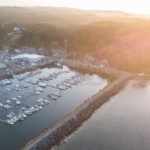







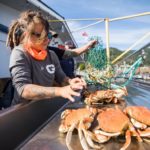
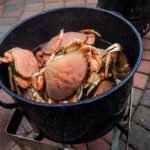


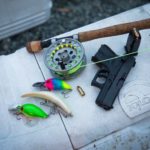














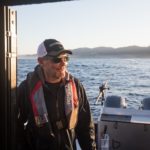




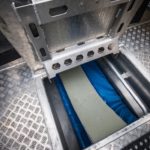
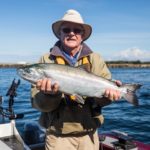






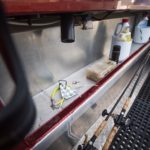


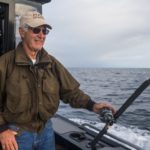




















Recent Comments